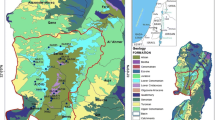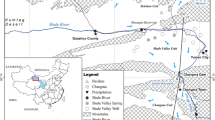Abstract
Figeh watershed spring is one of the important groundwater aquifer, which is considered a major source for drinking waters of Damascus city and countryside. The origin identification and recharge estimates of groundwater are significant components of sustainable groundwater development in this Mountain karst aquifer of Figeh spring. During the period 2001–2009, monthly groundwater and precipitation samples were taken and the isotopic compositions of δ18O, δ2H, and chloride contents were analyzed to identify groundwater origins and to estimate recharge rates. The δ18O, δ2H of the groundwater show that the groundwater recharge is of meteoric origin. The chloride mass balance (CMB) method was used to quantify recharge rates of groundwater in the Mountain karst aquifer of Figeh spring. The recharge rate varies from 192 to 826 mm/year, which corresponds to 43 and 67% of the total annual rainfall. Recharge rates estimated by CMB were compared with values obtained from other methods and were found to be in good agreement. This study can be used to develop effective programs for groundwater management and development.






Similar content being viewed by others
References
Al-Charideh A (2007) Environmental isotopic and hydrochemical study of water in the karst aquifer and submarine springs of the Syrian coast. Hydrogeol J 15:351–364
Al-Charideh A, Abou Zakhem B (2010) Distribution of tritium and stable isotopes in precipitation in Syria. Hydrol Sci J 55(5):1–13
Allison GB (1988) A review of some of the physical, chemical and isotopic techniques available for estimation ground-water recharge. In: Simmers I (ed) Estimation of natural ground-water recharge. D Reidel Publishing Co., Dordrecht, p 509
Allison GB, Hughes MW (1978) The use of environmental chloride and tritium to estimate total recharge to an unconfined aquifer. Aust J Soil Res 16:181–195
Bakalowicz M, El-Hajj A, El Hakim M, Al-Charideh A, Al-Fares A, Kattaa B, Fleury P, Brunet P, Dorfiger N, Seidel JL, Najem W (2007) Hydrogeological settings of karst submarine springs and aquifers of the Levantine coast (Syria, Lebanon). Towards their sustainable exploitation. Coastal aquifers: challenges and solutions, vol 1. Instituto Geologicoy Minero de Espana, Madrid, pp 721–732
Bazuhair AS, Wood WW (1996) Chloride mass-balance method for estimating ground water recharge in arid areas: example from western Saudi Arabia. J Hydrol 186:153–159
Craig H (1961) Isotopic variations in meteoric waters. Science 133:1702
Dansgaard W (1964) Stable isotopes in precipitation. Tellus 16:436
Dassi L (2009) Use of chloride mass balance and tritium data for estimation of groundwater recharge and renewal rate in an unconfined aquifer from North Africa: a case study from Tunisia. Environ Earth Sci. doi:10.1007/s12665-009-0223-1
DHV Water BV (2004) Coastal water resources Management project. Annex 1: assessment of the groundwater resources and recommendation for their development and management, version 1, unpublished report, Ministry of Irrigation, General Directorate of the Coastal Basin, Damascus
Droubi A (1988) Isotopic and chemical study of the Figeh spring in Syrian Arab Republic. ACSAD, unpublished report, Damascus
Edmunds WM, Fellman E, Goni IB, Prudhomme C (2002) Spatial and temporal distribution of groundwater recharge in northern Nigeria. Hydrogeol J 10:205–215
El-Hakim M, Bakalowicz M (2007) Significance and origin of very large regulating power of some karst aquifers in the Middle East. Implication on karst aquifer classification. J Hydrol 333:329–339
Eriksson E (1976) The distribution of salinity in groundwater of the Delhi region and the recharge rates of groundwater. In: Interpretation of environmental isotopes and hydrochemical data in groundwater hydrology. IAEA, Vienna, pp 171–177
Flint A, Flint L, Kwicklis E, Bodvarsson G (2002) Estimation recharge at Yucca Mountain, Nevada, USA, comparison methods. Hydrogeol J 10:180–204
Fontes J-Ch, Edmunds WM (1989) The use of environmental isotope techniques in arid zone hydrology—a critical review, IHP-III project 5.2, UNESCO, Paris, pp 1–75
Gat JR (1980) The isotopes of hydrogen and oxygen in precipitation. In: Fritz P, J-Ch Fontes (eds) Handbook of environmental isotope geochemistry, vol 1. The Terrestrial environment. Elsevier, Amsterdam, pp 21–48
Gat JR, Carmi I (1970) Evolution of the isotopic composition of atmospheric waters in the Mediterranean Sea Area. J Geophys Res 75:3039–3048
Grismer ME, Bachman S, Powers T (2000) A comparison of groundwater recharge estimation methods in semi-arid, coastal avocado and citrus orchard, Ventura County, California. Hydrol Process 14:2527–2543
Harrington GA, Cook PG, Herczeg AL (2002) Spatial and temporal variability of groundwater recharge in central Australia: a tracer approach. Ground Water 40(5):518–528
Houston J, Nazca SA (2007) Recharge to groundwater in the Turi Basin, northern Chile: an evaluation based on tritium and chloride mass balance techniques. Hydrogeol J 334(3–4):534–544
Japan international cooperation agency, JICA (1997) The study on water resources development in the northwestern and central basin in the Syrian Arab Republic. Final report, Damascus, Syria
Kattan Z (1997) Environmental isotope study of the major karst springs in Damascus limestone aquifer systems: case of the Figeh and Barada springs. J Hydrol 193:161–182
Lerner DN, Issar AS, Simmers I (1990) Groundwater recharge: a guide to understanding and estimating natural recharge, vol 8. International Association Hydrogeology, UNESCO, Hannover, Germany, p 345
Merlivat L, Jouzel J (1979) Global climatic interpretation of the deuterium–oxygen 18 relationship for precipitation. J Geophys Res 84:5029–5033
Meyboom P (1961) Estimating groundwater recharge from stream hydrographs. J Geophys Res 66:1203–1214
Scanlon BR, Healy RW, Cook PG (2002) Choosing appropriate techniques for quantifying groundwater recharge. Hydrogeol J 10:18–39
Seiler KP, Gat JR (2007) Groundwater recharge from run-off, infiltration and percolation, 1st edn. Springer, Dordrecht, p 241
Selkhozpromexport (1986) Water resources use in Barada and Auvage basins for irrigation of crops, Syrian Arab Republic, feasibility study, stage I, vol II. Natural conditions, Book 2, Hydrogeology. USSR, Ministry of Land Reclamation and water Management, Moscow
Shaw EM (1994) Hydrology in practice, 3rd edn. Chapman & Hall, London, p 569
Sogreah (1973) Etude hydrologique et hydrogelogique de la source Figeh, rapport final. R.11. 442; Grenoble, France
Subyani AM (2004) Use of chloride-mass balance and environmental isotopes for evaluation of groundwater recharge in the alluvial aquifer, Wadi Tharad, western Saudi Arabia. Environ Geol 46(6):741–749
Ting CS, Kerh T, Liao CJ (1998) Estimation of groundwater recharge using the chloride mass-balance method, Pingtung Plain, Taiwan. Hydrogeol J 6:282–292
Wood WW (1999) Use and misuse of the chloride-mass balance method in estimating ground water recharge. Ground Water 37:2–3
Wood WW, Sanford W (1995) Chemical and isotopic methods for quantifying ground-water recharge in a regional semi-arid environment. Ground Water 33:458–468
Zagana E, Obeidat M, Kuells Ch, Udluft P (2007) Chloride, hydrochemical and isotope methods of groundwater recharge estimation in eastern Mediterranean areas: a case study in Jordan. Hydrol Process 21:2112–2123
Acknowledgments
The author would like to thank Prof. I. Othman, Director General of AECS for use of their facilities during this study. I am also grateful to W.R. Agha and S. Rammah for their helpful comments and useful discussion. The author thanks the staff of the laboratories at the AECS for their cooperation in performing the isotopic and chemical analyses.
Author information
Authors and Affiliations
Corresponding author
Rights and permissions
About this article
Cite this article
Al-Charideh, A. Recharge rate estimation in the Mountain karst aquifer system of Figeh spring, Syria. Environ Earth Sci 65, 1169–1178 (2012). https://doi.org/10.1007/s12665-011-1365-5
Received:
Accepted:
Published:
Issue Date:
DOI: https://doi.org/10.1007/s12665-011-1365-5




